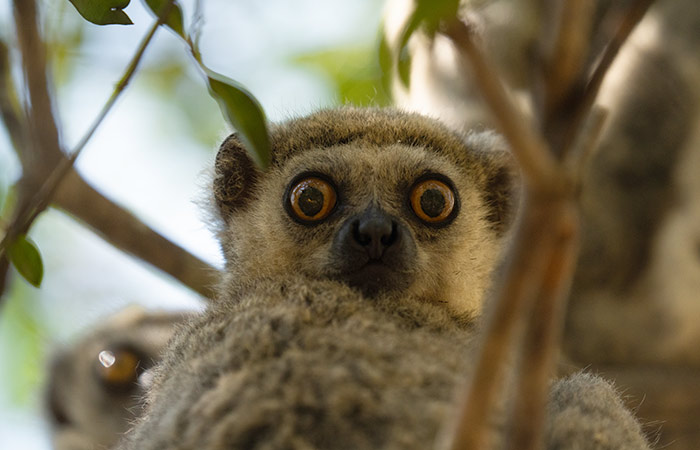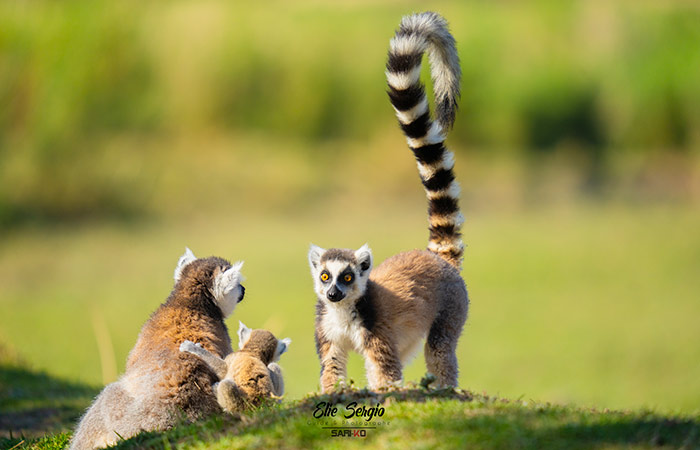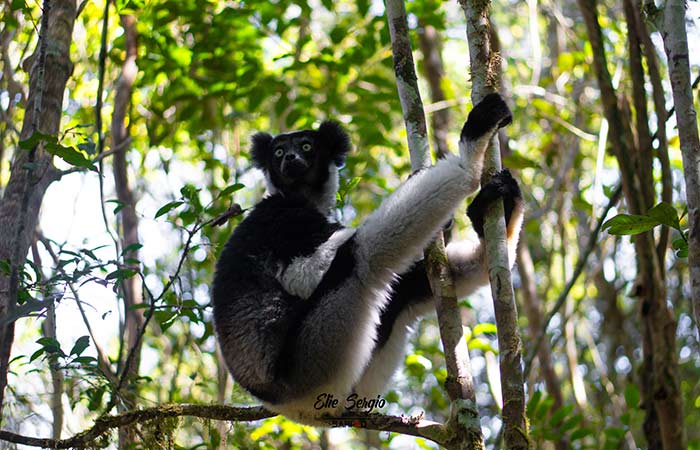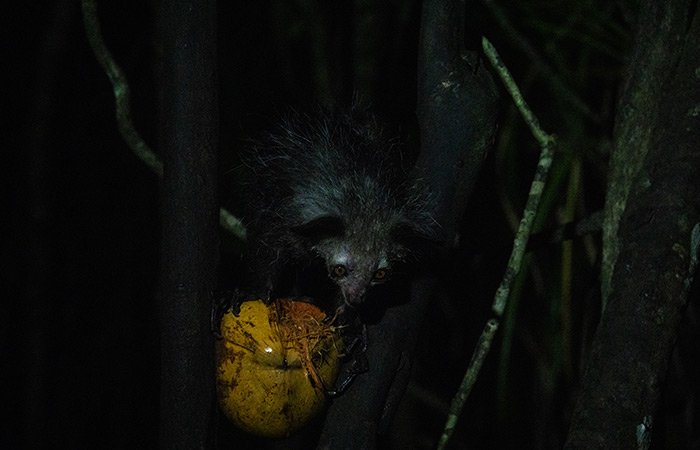The lemurs of Madagascar.
The Unique Primate Treasures of Madagascar.
Lemurs are fascinating creatures that offer a glimpse into the rich biodiversity of Madagascar. These primates, belonging to the suborder Strepsirrhini, capture the imagination of wildlife enthusiasts worldwide. Let’s dive into the world of lemurs and explore their classification, diversity, and conservation.

What Are Lemurs?
Lemurs are primates native to Madagascar, known for their large eyes, expressive faces, and diverse behaviors. They primarily inhabit the island’s lush rainforests and dry deciduous forests, where they thrive in the trees. With their strong limbs and gripping hands, lemurs are incredibly agile climbers. They spend most of their time in the canopy, making them largely arboreal creatures.
Lemur Classification.
Lemurs belong to the suborder Strepsirrhini, which distinguishes them from other primates like monkeys and apes. This group includes lorises and galagos, showing that lemurs are part of a broader family of unique primates.
Families of Lemurs.
Lemurs are divided into five main families, each exhibiting distinct characteristics.
Lemuridae (True Lemurs).

True lemurs are the most recognized group. They often have a social structure and are known for their vocalizations. The ring-tailed lemur is a prime example, often seen basking in the sun or moving in large groups.
The Ring-Tailed Lemur, Lemur catta, thrives in Madagascar’s Anja Community Reserve, where it captivates visitors with its distinctive black-and-white tail and social behavior. Living in matriarchal groups, these lemurs are highly interactive, often seen grooming and playing. Known for sunbathing with arms outstretched to warm up in the morning, they embody the unique wildlife experience Madagascar offers. Though locally protected, Lemur catta still faces threats from habitat loss elsewhere, highlighting the importance of community-led conservation efforts like those at Anja Reserve.
Indriidae (Indri, Sifakas, and Woolly Lemurs).

Indriids are notable for their larger size and unique behaviors. The indri, for instance, is known for its loud, haunting calls that can be heard across the forest. Sifakas are famous for their graceful leaps between trees.
The Indri, Indri indri, is Madagascar’s largest lemur and an extraordinary inhabitant of the lush Mitsinjo Reserve. Known for its haunting, melodic calls that echo through the rainforest, the Indri communicates over long distances to mark its territory and stay connected with family groups. With its dense black-and-white fur and expressive face, this lemur is easily recognized, and it lives in small family groups that exhibit remarkable social bonds. The Indri’s diet consists mainly of leaves, making it highly dependent on intact forest habitats.
Lepilemuridae (Sportive Lemurs).

Sportive lemurs are characterized by their large eyes and nocturnal habits. They are adept at climbing and often rely on their strong legs to navigate their arboreal habitats.
The family Lepilemuridae, commonly known as sportive lemurs, consists of around 26 species, each adapted to different regions of Madagascar. These nocturnal lemurs are solitary and elusive, characterized by their large eyes for enhanced night vision and strong hind limbs that allow them to leap between trees with agility. Primarily folivorous, sportive lemurs have a specialized digestive system to process leaves, which they ferment in an enlarged cecum. They also exhibit unique vocalizations and communicate through scent marking.
Cheirogaleidae (Dwarf and Mouse Lemurs).

These small lemurs, including dwarf and mouse lemurs, are the tiniest primates in the world. Their size allows them to hide among the foliage, making them less visible to predators.
The family Cheirogaleidae includes some of the smallest primates in the world, such as dwarf and mouse lemurs, all native to Madagascar. These tiny, nocturnal lemurs weigh between 30 to 500 grams and are known for their large eyes, which provide excellent night vision, and their incredible agility in the forest canopy. They have a diverse diet that includes fruits, nectar, insects, and even small vertebrates, playing a vital role in pollination and seed dispersal. Many species, like the fat-tailed dwarf lemur, go through seasonal torpor or hibernation, storing fat in their tails to survive periods of food scarcity.
Daubentoniidae (Aye-aye).

The aye-aye stands out as one of the most distinctive lemurs in existence. With its elongated middle finger, it taps on trees to find insects. This unique feeding method is a prime example of evolutionary adaptation.
The Aye-aye (Daubentonia madagascariensis), a member of the Daubentoniidae family, is one of Madagascar’s most enigmatic and unique lemurs. Known for its unusual features—large, expressive eyes, a bushy tail longer than its body, and an elongated middle finger—the Aye-aye is a nocturnal forager. It uses this specialized finger to tap on tree trunks and listen for hollow spots, then extract insects with remarkable precision, making it an extraordinary example of evolution. Though considered mysterious and even eerie by some, the Aye-aye plays a vital role in Madagascar’s ecosystem, maintaining insect populations and promoting forest health.
Current Species Count:
As of the latest updates, around 112 recognized species and subspecies of lemurs exist. This number reflects the incredible diversity among lemurs, showcasing various adaptations to their environments. However, this count is subject to change as new discoveries and taxonomic revisions occur.
Comparison with Other Primates:
While lemurs, galagos, and lorises share similarities, tarsiers are more closely related to monkeys than to lemurs. Galagos are small and agile, native to Africa, while lorises inhabit both Africa and Asia. Tarsiers, found in Southeast Asia, are known for their large eyes and nocturnal behavior. This intricate web of relationships showcases the vast diversity within the primate order.
Behavior and Ecology
Lemurs are primarily arboreal, relying on their adaptations for a life in the trees. Their social structures vary by species, with some living in large groups while others prefer solitary lifestyles. Communication among lemurs is crucial, using vocalizations, scent marking, and body language to convey messages.
Conservation Status.
Unfortunately, lemurs face significant threats, including habitat loss, hunting, and climate change. There are ongoing conservation initiatives aimed at safeguarding these extraordinary primates. Organizations work tirelessly to raise awareness and implement protective measures in Madagascar.
Conclusion:
Lemurs are not just adorable creatures; they represent a unique part of our planet’s biodiversity. Understanding their classification, behavior, and conservation needs is crucial for their survival. As we learn more about these fascinating animals, we must also recognize the importance of protecting their habitats for future generations.
